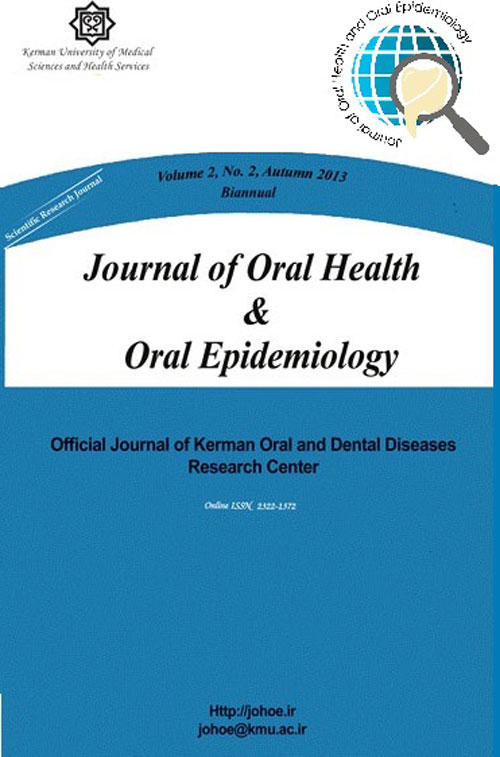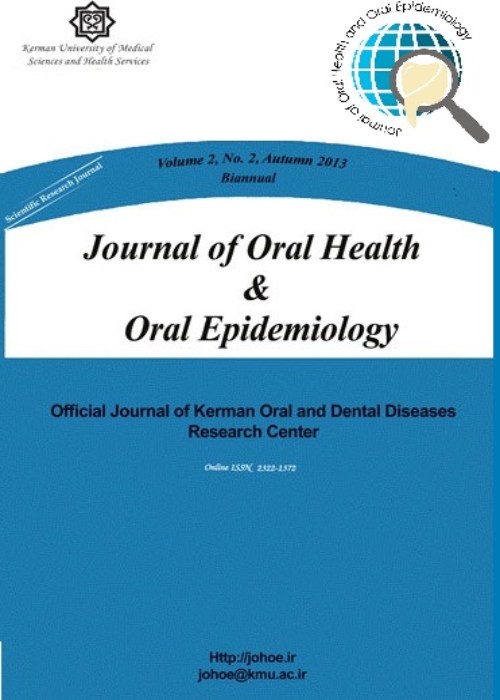فهرست مطالب

Journal of Oral Health and Oral Epidemiology
Volume:11 Issue: 1, Winter 2022
- تاریخ انتشار: 1401/03/07
- تعداد عناوین: 8
-
-
Pages 1-4
-
Pages 5-12BACKGROUND AND AIM
Recurrent aphthous stomatitis (RAS) is the most common chronic disease of the oral cavity with 5-25% morbidity. Etiopathogenesis is still unclear and there is no certain cure for the disease. This study was conducted systematically to access the therapeutic effects of systemic (oral) corticosteroids on oral aphthae.
METHODSThis systematic review study was conducted according to the Cochrane’s recommended manual, and clinical trial studies that compared oral systemic corticosteroids with placebo or other drugs, were considered eligible to include. For this purpose, keywords were determined using Mesh system and were searched through the Boolean searching method using “and” and “or” in the PubMed, Cochrane Library, Scopus, Web of Science, and Google Scholar databases. In order to increase sensitivity, time and language limitations were not implemented. Afterwards, all of the searched studies were evaluated and the required information was obtained.
RESULTSIn this systematic review, only five clinical trials were involved. In all of the studies, prednisone or prednisolone (the active form of prednisone) was used as a systemic corticosteroid, rather than systemic drugs such as colchicine, sulodexide, montelukast, levamisole, and placebo. In general, this drug was effective in healing aphthous symptoms.
CONCLUSIONThere were few clinical trials using systemic corticosteroids. The results of this study showed that low prednisolone dosage combined with levamisole was effective in curing aphthae with no serious side effects.
Keywords: Aphthous Stomatitis, Aphthous Ulcers, Aphthae, corticosteroid -
Pages 13-18BACKGROUND AND AIMGingivitis is an inflammation of oral soft tissue without attachment loss as a result of bacterial aggregation. The aim of this study was to compare the effect of topical curcumin nanodrug gel and chlorhexidine (CHX) mouthwash on the treatment of gingivitis.METHODSIn this study, 40 patients who had generalized chronic gingivitis and symptoms of redness and inflammation of the gums, as well as bleeding on probing (BOP) without attachment loss were enrolled and divided into two groups of 20 members. In one group, scaling and root planing (SRP) with the use of CHX 0.2% (twice a day for a week) was prescribed, and in the other group, SRP was done with the use of topical curcumin 1% nanogel (once a day), which was injected in gingival sulcus. Then, plaque index (PI), gingival index (GI), and BOP were measured and compared at three times (before treatment, 2 weeks and one month after treatment). 5 patients did not attend in the follow-up sessions; therefore, the results were presented with 35 patients.RESULTSBOP, GI, and PI significantly reduced in the first, second, and third times in both CHX and curcumin groups (P ≤ 0.04). The average of PI in CHX group was higher than that in curcumin group in the second and third times, but the difference was statistically significant only in the third time (P = 0.014).CONCLUSIONBased on the results of this study, curcumin as an herbal compound in gel form significantly improves gum status and clinical parameters (BOP, GI, and PI); therefore, it can be used in addition to mechanical treatments.Keywords: curcumin, Chlorhexidine, Gingivitis, dental plaque
-
Pages 19-24BACKGROUND AND AIMThe aim of this study was to investigate the effect of bruxism on mandibular morphology, by comparing different mandibular measurements of bruxers and non-bruxers on panoramic radiographs.METHODSData of 71 patients (32 bruxers and 39 non-bruxers) who referred to the Department of Oral and Maxillofacial Surgery, School of Dentistry, Ordu University, Ordu, Turkey, from 2016 to 2019, were retrieved from the archival records. The canine-molar height, ramus width, coronoid height-width, and gonial angle were measured with Turcasoft software on panoramic radiographs obtained from the patients’ radiographic archival records. Statistical analyses were performed using the SPSS software, and comparisons of the measurements between bruxers and non-bruxers were performed using independent samples t-test or Mann-Whitney U test, as appropriate. The categorical data were analyzed using chi-square test.RESULTSData of 71 patients (22 males, 49 females) aged 15-51 years were analyzed in this study. Regarding coronoid measurements, the left and right coronoid height and left coronoid width measurements were found significantly higher in bruxers than those in non-bruxers (P = 0.025, P = 0.041, P < 0.001). Although all gonial angle, ramus width, and molar and canine height measurements were higher in bruxers than those in non-bruxers, these differences were not statistically significant. Additionally, no significant differences were observed in any variable between bruxers and non-bruxers for both genders.CONCLUSIONGiven the results of the present study, the morphological changes of the mandible as a consequence of bruxism may be expressed with the changes in coronoid dimensions. However, to reach a definitive conclusion, further prospective clinical studies with larger sample sizes and longer follow-up periods are needed.Keywords: Muscles, mandible, Bruxism
-
Pages 25-31BACKGROUND AND AIMThis study aimed to retrospectively determine the prevalence of ectopic eruption observed in permanent teeth during the mixed dentition period and the complications caused by it, based on radiographic findings.METHODSThis study included children aged 6-12 years admitted to the Department of Pediatric Dentistry, Tokat Gaziosmanpaşa University. The orthopantomographic radiographs of 2664 patients were used to examine anterior and premolar teeth by two different researchers. The patient's age and gender, the teeth with ectopic eruption, and complications caused by it on the jaw, adjacent teeth, and arch were recorded.RESULTSEctopic eruption was observed in 176 patients (91 girls and 85 boys) out of 2664 patients included in the study and the prevalence rate was 6.6%. The eruption complications were observed in 131 of 176 patients with ectopic eruption (4.9%). Among the complications, the most common and the least common complications were the reduction in the arch length (1.2%) and the impaction of the adjacent permanent tooth (0.1%), respectively. The ectopic eruption was mostly common in premolar teeth.CONCLUSIONThe early radiographic diagnosis of ectopic eruption can lead to more manageable and more acceptable methods of treatment with no need to adopt complicated treatments in appropriate cases, providing a great advantage for both the patient and the dentist.Keywords: Ectopic Eruption, Prevalence, Complicity, Early Diagnosis
-
Pages 32-39BACKGROUND AND AIMOral health is an integral part of general health. There are many epidemiological studies on oral health of school-aged children; however, orphan oral health has been neglected. This study aimed to evaluate oral health status and oral hygiene behaviour of orphans who are living in care home.METHODSAll children aged between 6-18 years who were living in 20 orphan care homes participated in the study after acquiring legal permission and signing consent form. Data of dental caries, gingival health, and oral hygiene factors were recorded by a trained dentist using World Health Organization (WHO) oral health basic survey methods. Descriptive analysis was performed to reach the study aim and objectives.RESULTSTotally, 356 children participated, with 50.6% of male group. The study subjects were classified in two age groups of 6-12 and 13-18 years old. Mean decayed, missing, and filled teeth (DMFT)/dmft was 1.73 ± 1.84 and 4.13 ± 3.80 in 6-12-year-old group, respectively. Only 39.5% of 13-18-year-old group had healthy gingiva. Mean of plaque index (PLI) was 0.98 ± 0.86 for whole study population. There was a significant relationship between gender and PLI and also tooth brushing behaviour.CONCLUSIONOral health of orphan children is not adequate. Therefore, regular dental check-up and oral health education programs are necessary.Keywords: Oral Health, Orphaned, Home Care Services, Iran
-
Pages 40-46BACKGROUND AND AIM
Pregnant women should take special care of the oral cavity and perform additional hygiene procedures. In this study, the oral health status of perinatal patients was compared to that of women who have never been pregnant by analyzing the Simplified Oral Hygiene Index (OHI-S).
METHODSThe study group consisted of 125 patients in the perinatal period, hospitalized at the Institute of the Polish Mother's Health Center in Lodz, Poland. The control (comparison) group included 100 women. Patients from both groups underwent clinical examination of the teeth and periodontium condition and a survey was conducted as well. The epidemiological indicators were used to compare and interpret the results. The OHI-S was used to determine the state of hygiene.
RESULTSThere was no statistically significant difference in the mean values of OHI-S, Simplified Debris Index (DI-S), and Simplified Calculus Index (CI-S) between the two study groups. It was shown that respondents maintained oral hygiene at a similar level. Most of the respondents revealed high therapeutic needs. Statistical relationships appeared in the analysis of environmental factors.
CONCLUSIONPregnant women do not attempt to improve hygienic condition of the oral cavity. Despite their hormonal and behavioral predispositions, pregnant women maintain hygiene at a similarly low level as non-pregnant women. Pregnancy itself does not worsen hygienic condition of the oral cavity. Dentists should pay attention to the oral health of pregnant women.
Keywords: Dental Care, Gingivitis, Oral Hygiene Index, Oral hygiene, Pregnancy -
Pages 47-54BACKGROUND AND AIM
The aim of this study was to examine the relationship between alexithymia and anxiety levels in patients accepted to orthodontics for the first time and patients admitted for orthodontic treatment.
METHODSThe study enlisted the participation of 200 individuals ranging in age from 11 to 20 years. The Toronto Alexithymia Scale-20 (TAS-20), State-Trait Anxiety Inventory (STAI), Orthodontic version of modified dental anxiety scale (MDASO), and orthodontic concerns list (OCL) questionnaires were used to assess the patients' alexithymia and anxiety levels. The level of statistical significance was set at P < 0.05.
RESULTSThe "alexithymia" values evaluated using the TAS-20 questionnaire were found to be higher in boys than in girls. "state and trait anxiety" evaluated using STAI questionnaire did not differ between patients who applied to the orthodontic clinic for the first time and patients who were accepted for orthodontic treatment. "Orthodontic anxiety" evaluated using the MDASO questionnaire was found to be higher in individuals in the 11-15 age group compared to the individuals in the 16-20 age group.
CONCLUSIONThe assessment of various personality and psychological conditions such as anxiety and alexithymic characteristics of individuals who applied for orthodontic treatment and were accepted for treatment should not be overlooked and should be performed at the start of long-term treatments such as orthodontic treatment.
Keywords: Orthodontic treatment, alexithymia, Anxiety


